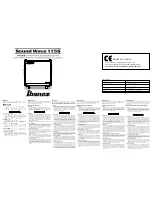
8
be used. The SOLID STATE DIRECT INPUT
and the VACUUM TUBE DIRECT INPUT will
feed their respective Outputs. The SOLID STATE
OUTPUT can be connected to one Loudspeaker and
the VACUUM TUBE OUTPUT can be connected
to another. Each Amplifier section of the MC901
will be generating full frequency signals. A
Preamplifier’s Output Selector can be used to toggle
between Solid State and Vacuum Tube output. For
Stereo, a second MC901 is required in all cases.
Power Control
Power Control allows the MC901 to send (OUT)
and receive (IN) On/Off signals to/from other
McIntosh equipment. In this way, powering on or
powering off a single component can do the same
for multiple units.
The Power Control Input Jack accepts an On/Off
signal from +5 to +12 volts. Meter Lights can be
controlled as well. The Power Control Output will
provide a +12 volt signal with a total current up to
25 mA. Connections are made using an 1/8 inch
stereo mini phone plug with the following wiring:
Figure 06–
Control
Trigger
Ground
Meter
Illumination
Control
Power Control (trigger) mini plug
Auto Off Switch
When the AUTO OFF Switch is in the ENABLE
position, the MC901 will automatically power off
when there has been 30 continuous minutes of not
receiving any input signal.
When the AUTO OFF Switch is in the DISABLE
position, the MC901 will remain on unless manually
powered off.
Connecting a Speaker
A Question of Impedance
The MC901 is designed for two separate
connections to a single Loudspeaker. The Solid
State Amplifier Output Terminals should be
connected to the Low Frequency Terminals of your
Loudspeaker. The Vacuum Tube Amplifier will
be connected to the High/Mid Terminals of your
Loudspeaker.
Based on the specifications of your Loudspeaker,
determine the best impedance to use for each
connection. Each Amplifier has a pair of 2 Ohm, 4
Ohm and 8 Ohm Output terminals. Keep in mind
that the impedance rating of your Loudspeaker is
an average over a range of frequencies. It would
be helpful if you have a curve that shows your
Loudspeaker’s impedances over the frequency
range. A Loudspeaker rated 8 Ohm may be closer
to 4 Ohm on the low end. It is a safe bet to use the
lower impedance Output Terminals for a speaker
whose impedance falls between two choices. For
example, using the 4 Ohm Output Terminals for
a 6 Ohm Loudspeaker will give a slightly cleaner
signal. It is very possible that some Loudspeakers
will work best with 4 Ohm Output Terminals for
the High/Mids and 8 Ohm Output Terminals for the
Woofers.
The Speaker Wire
If speaker wire is not already terminated, remove
½ inch (12.7mm) of insulation from the wire end
and twist the strands together. For runs under 25
feet (7.6m), use at least 16AWG wire. For runs
under 50 feet (15.2m) use at least 14AWG, and for
longer runs up to 100 feet (10.5m), use 12AWG.
12AWG, being the larger wire, can be used in all
the above cases if desired. The above guidelines are
for 8 Ohm connections. When using 4 Ohm speaker
connections, subtract 2 from the gauge. For 2 Ohms
subtract 4. For example, a minimum gauge for a 50
foot 2 ohm run would be 10AWG. See Figure 07.
Generally, thicker gauge wire is better than thinner
until it doesn’t fit in the Output Terminal hole.
Loudspeaker Wire Gauge Guide
Impedance
25 feet
(7.62
meters)
or less
50 feet
(15.24
meters)
or less
100 feet
(30.48
meters)
or less
2 Ohms
12AWG
10AWG
8AWG
4 Ohms
14AWG
12AWG
10AWG
8 Ohms
16AWG
14AWG
12AWG
Figure 07– Loudspeaker Wire Gauge Guide
The Output Terminal Hookup
When connecting the speaker wire to the MC901
Output Terminals, please follow these steps:
• Make sure AC Power is disconnected
• Determine which pair of Output Terminals
to use (2 Ohm, 4 Ohm or 8 Ohm). Pay close
attention to the Polarity (+/-).
Proper Polarity
must be maintained for all connections





































